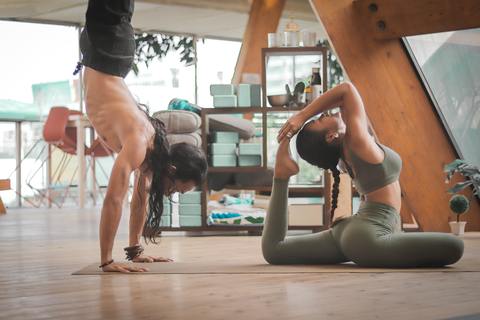Your cart is currently empty!


The NHS’s physical activity guidelines recommend exercising 30 minutes a day. We exercise for various reasons, including losing weight, build endurance or strengthen bones, but in times of confinement, exercise is also a good way to decrease stress and anxiety. Several studies have shown that exercise can lift your mood, and one major review of studies found that both aerobic exercise and resistance training can help fight depression [1]. Finally, with the high level of stress caused by the COVID-19 pandemic, we can have trouble sleeping – if you’re moving, you will sleep better.
Getting into an indoor fitness routine requires the right set-up and a plan. Here are four steps to help you get started and maintain your healthy habits.
- Find a coach or fitness programme online
If you are serious about your fitness training, it is better to follow a programme that has been put together by a professional. It will help you make sure you get a full-body workout and do the exercises in the right way. There are plenty of online coaches you can find on apps, YouTube, or Instagram. Especially in a COVID-19 world, a lot of athletes, personal trainers and teachers converted to free online classes to help people keep fit. Some of my favourites are: Kayla Itsines (a classic, good for a mix of cardio and HIIT training) and tomtriathlete (who just started Instagram live videos of him training at home). Wellness app Urban just launch a digital service called ‘Stay at Home Club’, where you can find online yoga and gym classes, but also physiotherapy and mindfulness sessions. Yogi2Me also offers free online yoga classes.
Now, you might wonder how to do all these exercises without the right equipment but look again at your apartment and you will find what you need.
- Gather equipment in your home
For squats, lunges and abs, you don’t need much apart from a comfortable floor. For other exercises you will find in most fitness programmes, you can replace gym equipment with objects and furniture. For example, you can use 2L water flasks or 1kg pasta bags instead of dumbbells. If you usually use a bench in your workout sessions, use a chair instead. Full laundry bags can be used instead of medicine balls, and your bed, your couch or stairs will prove helpful to do step-ups. Alternate indoor exercises with walks and runs outside, while respecting social distancing rules.
- Plan your day
Getting into a routine is paramount to achieve your goals. For sustained improvement, consistency is key: choose a time you will exercise every day and try to stick to it. Depending on your goals – loosing weight, building muscle mass or staying fit – exercise a minimum of 20 minutes a day. Most fitness programmes include between 20 and 30 minutes of exercises.
Find a partner to get into your routine. Counting on someone who shares the same objectives as yours is motivating and makes achieving one’s goals easier on the long run. This partner could be a family member, an online coach or a friend. Find a time to meet your partner online and exercise together. Digital challenges are also a fun way of pushing your limits.
- Make sure to take care of yourself
With the right mindset, partner, programme and equipment, you have everything you need to start training. However, you will only achieve your long-term goals if you treat your body kindly. Here are three key aspects of a wellness routine you need to incorporate in your life to make your fitness journey an enjoyable and effective one:
- Stretch well before and after each work-out session and spend 20 minutes stretching only, one day a week.
- Eat well and drink up. Favour a healthy breakfast, eat large meals three to four hours before exercising, snack well (with an energy bar, fruit juice, a low-fat granola bar or bananas and apples for example) and drink before, during and after exercise to help prevent dehydration. Read our blog here on what food to eat to avoid muscle soreness.
- Massage fatigued, over worked-out muscles and joints. Massages are particularly helpful to stimulate an increase in blood flow and avoid damage in the muscles. Nutrients such as calcium and iron are carried within the blood which are essential to keep muscles healthy and strong, as well as oxygen which provides energy within the working muscles. Use our Relief Balm in your massage to target over-worked-out muscles and joints at the source and help faster recovery.
[1] https://www.businessinsider.com/depression-symptoms-reduced-by-strength-training-exercise-2018-5?r=US&IR=T